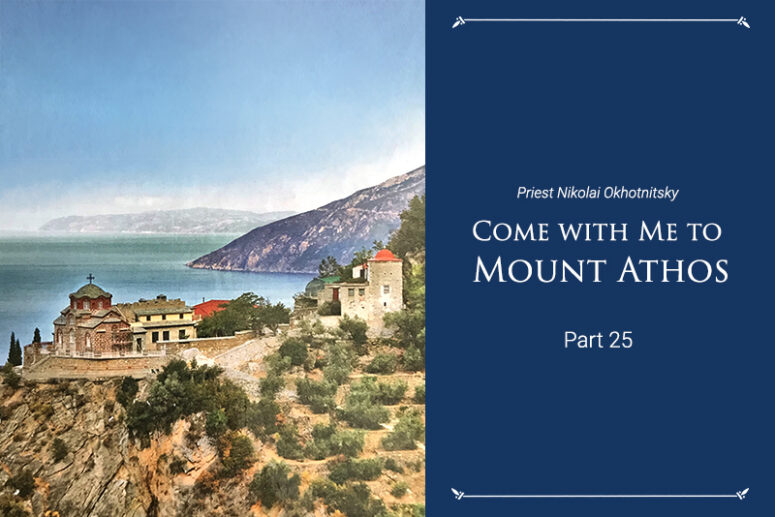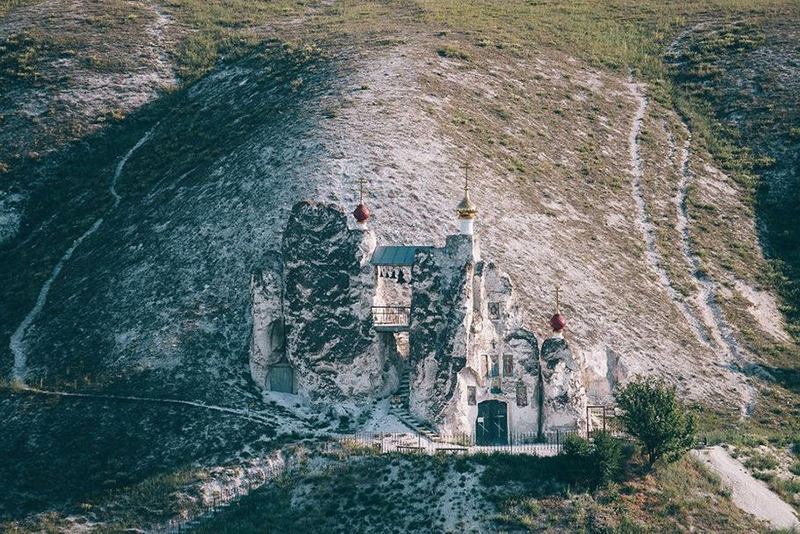
Galaktotrophousa
We walked out of the church and sat in silence near the rocket-bell tower, still dwelling in our inner spaces. Again, the guidance and care from above manifested itself in the form of two Ukrainian brothers who appeared in front of us and asked:
– Have you been to the Milk-giver Icon already?
– ???
– This famous icon was brought to Athos from Palestine in the 13th century by Saint Sava of Serbia and left as a gift to the Hilandar monastery. This icon is famous for many miracles and is now kept here, in the Karyes skete. We can take you there if you would like.
– Of course! Please, take us there! – We were excited in a good way.
– Is it far? – Igor asked with a shadow of apprehension.
– No, not far. But if you don’t know your way, you won’t find it.
We walked along the narrow alleys, climbing higher and higher up the mountain. Overcoming a steep staircase, we found ourselves in front of a house surrounded by rose bushes and looking more like a solid hut than a church. The guys knocked on the locked door. We looked around and immediately took out our cameras to capture the stunning view of the summit of Athos, the sea and Karyes itself. Our photoshoot did not last long. The sound of the turning key made us line up quickly in front of the door. A gloomy elderly monk came out and let us in, muttering something quietly under his breath. Maybe he was reading a prayer. It took me a while to understand why someone like us would often be met with seemingly unfriendly and unhappy faces. But after some time on the Holy Mountain I noticed the never-ending flow of pilgrims depriving the Athonites, longing for solitude and prayer, of their peace and quiet. Every knock on the door makes these holy men stop what they are doing and let in people like us, with lost faces and restless eyes. No wonder they were sometimes “rumbling” their prayers.
The Milk-giver icon is also historically called Typikonissa. This name comes from the word “Typikon”, since the Rule (Typikon) of Saint Savva was preserved there. For unknown reasons the icon was unconventionally located to the right of the holy doors, and not to the left, as usual. The church itself looked small, about 4×4 meters. We were in no hurry to leave, which the gloomy monk was tolerating in silence. Again, time stopped for us.
Time always amazes me with its uneven flow that I have noticed so many times in my life. Or maybe it is not the time but my perception that changes? An old woman once told me how she spent almost the entire war in Nazi concentration camps. When she was being taken to Germany with two small children, her grandmother managed to slip a piece of Easter artos into her hand. She let me hold that porous, yellowish-gray piece of holy bread in my hands. Zinaida Fedorovna Pogerilo (that was her name) told me how, during the shelling of the Curonian Spit (not far from Kaliningrad, where the Neman river flows into the Baltic Sea), a red-hot, fiery-orange missile fell near her face (she was lying in a funnel with her daughter). She said that it was almost transparent, and everything around her suddenly slowed down then. She seemed to have fallen out of the flow of time and observed in surprise the microscopic circumstances that usually elude people’s attention. The shell did not explode. Zinaida Fedorovna never doubted that God took care of her through that artos bread.
Many people notice how transient days and years are. Perhaps this is what the Gospel describes by the words “…but for the sake of the elect those days will be cut short” (Matt. 24,22)? Perhaps, these are only my subjective experiences, but the current of time does seem to flow quieter near the “banks” of this river, while it rushes at its straits.
My family and I once came to see Father Nikolai Guryanov in 1999. We lived on the island for three days, but the internal clock of my soul was showing that our stay there lasted for at least a month…
After prayer, we returned happily to the main square of Karyes.
Translated by The Catalogue of Good Deeds




